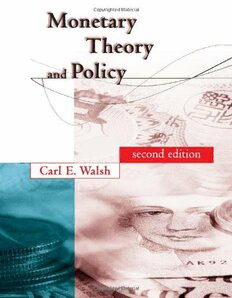Download Monetary Theory and Policy Edition 2 PDF Free - Full Version
Download Monetary Theory and Policy Edition 2 by Carl E. Walsh in PDF format completely FREE. No registration required, no payment needed. Get instant access to this valuable resource on PDFdrive.to!
About Monetary Theory and Policy Edition 2
Monetary Theory and Policy presents an advanced treatment of critical topics in monetary economics and the models economists use to investigate the interactions between real and monetary factors. It provides extensive coverage of general equilibrium models of money, models of the short-run real effects of monetary policy, and game-theoretic approaches to monetary policy. Among the topics covered are money-in-the-utility-function models, cash-in-advance models, money and public finance, the credit channel of money, models of time consistency, monetary policy operating procedures, and interest rates and monetary policy. The book uses dynamic simulations to evaluate quantitatively the significance of the channels through which monetary policy and inflation affect the economy. It extensively examines modern approaches to monetary policy that stress the incentives facing central banks and the strategic interactions between central banks and the private sector. Where most treatments of monetary policy emphasize money supply control and money demand, this book focuses on the implications of interest rate control for monetary policy. The book is designed for advanced graduate students in monetary economics, economic researchers, and economists working in policy institutions and central banks. This second edition includes new discussions of empirical evidence on the interest elasticity of money demand, the fiscal theory of the price level, the new Keynesian model, optimal policies in forward-looking models, stability and the Taylor principle, and open economy new Keynesian models. It also expands its coverage of multiple equilibria, the role of timing assumptions in cash-in-advance models, and the Ramsey approach to optimal monetary taxation. A new chapter treats policy analysis in new Keynesisan models; the discussion includes the derivation of the policy objective function, optimal commitment and discretionary outcome, targeting rules,and instrument rules.
Detailed Information
| Author: | Carl E. Walsh |
|---|---|
| Publication Year: | 2003 |
| ISBN: | 9780262232319 |
| Pages: | 633 |
| Language: | English |
| File Size: | 7.358 |
| Format: | |
| Price: | FREE |
Safe & Secure Download - No registration required
Why Choose PDFdrive for Your Free Monetary Theory and Policy Edition 2 Download?
- 100% Free: No hidden fees or subscriptions required for one book every day.
- No Registration: Immediate access is available without creating accounts for one book every day.
- Safe and Secure: Clean downloads without malware or viruses
- Multiple Formats: PDF, MOBI, Mpub,... optimized for all devices
- Educational Resource: Supporting knowledge sharing and learning
Frequently Asked Questions
Is it really free to download Monetary Theory and Policy Edition 2 PDF?
Yes, on https://PDFdrive.to you can download Monetary Theory and Policy Edition 2 by Carl E. Walsh completely free. We don't require any payment, subscription, or registration to access this PDF file. For 3 books every day.
How can I read Monetary Theory and Policy Edition 2 on my mobile device?
After downloading Monetary Theory and Policy Edition 2 PDF, you can open it with any PDF reader app on your phone or tablet. We recommend using Adobe Acrobat Reader, Apple Books, or Google Play Books for the best reading experience.
Is this the full version of Monetary Theory and Policy Edition 2?
Yes, this is the complete PDF version of Monetary Theory and Policy Edition 2 by Carl E. Walsh. You will be able to read the entire content as in the printed version without missing any pages.
Is it legal to download Monetary Theory and Policy Edition 2 PDF for free?
https://PDFdrive.to provides links to free educational resources available online. We do not store any files on our servers. Please be aware of copyright laws in your country before downloading.
The materials shared are intended for research, educational, and personal use in accordance with fair use principles.

